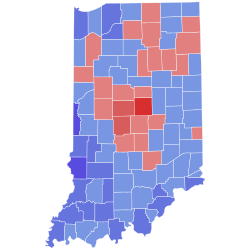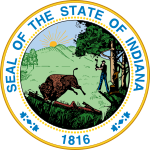1988 Indiana gubernatorial election
| ||||||||||||||||||||
| ||||||||||||||||||||
 County results Bayh: 50–60% 60–70% 70–80% Mutz: 50–60% 60–70% 70–80% | ||||||||||||||||||||
| ||||||||||||||||||||
| Elections in Indiana |
|---|
 |
The 1988 Indiana gubernatorial election was held on November 8, 1988, in all 92 counties in the state of Indiana. Incumbent Governor Robert D. Orr, a Republican, was ineligible to run for a third consecutive term due to term limits establish by the Indiana Constitution. In the general election, the Republican nominee, Lieutenant Governor John Mutz, was defeated by Democrat Indiana Secretary of State Evan Bayh by a margin of six percentage points. Bayh was the first Democrat to be elected Governor of Indiana since Roger D. Branigin's victory during the 1964 Democratic landslides twenty-four years previously.
Primaries
Republican Party
- John Mutz, incumbent Lieutenant Governor of Indiana
While the Republicans controlled the governor's mansion going into the 1988 elections, they were unable to nominate the incumbent governor, Robert D. Orr, due to term limits set in place by the Indiana Constitution. With Orr out of the running, the obvious choice to succeed him was his lieutenant governor, John Mutz. Mutz did not face a challenger for the nomination, and consequently rolled up 393,595 votes in the 1988 Republican primary election, a total that was nevertheless a little less than 100,000 votes fewer than his Democratic opponent, Secretary of State Evan Bayh, received in a three-way race for the Democratic nomination.
| Party | Candidate | Votes | % | |
|---|---|---|---|---|
| Republican | John Mutz | 393,595 | 100.00 | |
Democratic primary
- Evan Bayh, Secretary of State of Indiana
- Steve Daily, Mayor of Kokomo
- Frank O'Bannon, State Senator (withdrew)
While the Republican primary was a specific coronation of Mutz, the contest for the Democratic nomination was anything but. Three candidates initially contested the nomination: Evan Bayh, the incumbent Secretary of State of Indiana and son of former U.S. Senator Birch Bayh; Steve Daily, then-mayor of Kokomo; and Frank O'Bannon, a member of the Indiana State Senate. From the outset, Bayh was seen as the front runner in the race, and O'Bannon would eventually bow out to accept Bayh's offer to run for Lieutenant Governor, leaving Daily as the only challenger to the young politician who was being called "Indiana's Democratic boy wonder".[1][2]
Hoping to prevent the nomination of a candidate who might upend their dominance in Hoosier politics, state Republicans led by Governor Orr filed a legal challenge to Bayh's candidacy, claiming that he did not meet the residency requirements for candidates for the state's highest office and demanding that he be removed from the ballot. The attempt backfired: rather than neutralizing Bayh, the legal challenge actually boosted his standing in the race. On April 28, the Indiana Supreme Court found that Bayh did, in fact, meet all residency requirements set forth in the state's Constitution, ending any threat to the candidate's ballot access. Simultaneously, the challenge allowed Bayh to cast himself as the underdog and a target of the Republican political machine, calling the challenge a "rather sad commentary" on Republican confidence in Mutz.[2][3]
Bayh won the Democratic nomination with 493,198 votes, or 83.1%
| Party | Candidate | Votes | % | |
|---|---|---|---|---|
| Democratic | Evan Bayh | 493,198 | 83.1 | |
| Democratic | Steve Daily | 66,242 | 11.1 | |
| Democratic | Frank O'Bannon | 34,360 | 5.8 | |
General election
Throughout the fall campaign, Mutz attempted to capitalize on Bayh's youth by casting him as inexperienced and unfit to lead Indiana from the governor's mansion. Accusing Bayh of being more interested in a potential Senate run than in being governor, Mutz drew a distinction between his own extensive record in state government and Bayh's relatively recent arrival on the political stage. Comparing Bayh to an unqualified job applicant, Mutz wondered aloud if Hoosiers would "employ someone who has lived in this state only a handful of years, by anybody`s measure, and who has only a year's experience in that system?" Bayh returned fire by attacking Mutz as the candidate of the political machine. Despite the attacks, the two candidate's platforms showed remarkable similarity. Both Bayh and Mutz were committed to education reform, and both pledged to make government more efficient and to promote economic growth. Speaking to the New York Times, Bayh's campaign manager acknowledged that the Democrat was running on a relatively conservative platform. "I'd like to say that Hoosiers are an independent lot", he said.[2][4]
On election night, Bayh defeated Mutz by a comfortable margin, winning 53% of the vote to Mutz's 47%. Bayh's victory was remarkable for a number of reasons. First, a Democrat had not been elected governor of Indiana since 1964, a year that had seen a landslide for Democrats up and down the ballot. Second, he was the youngest governor in the nation at the time of his election, his 33rd birthday taking place nearly two months after election day. Third, Indiana was carried by the Republican ticket (which featured Indiana Senator Dan Quayle as the vice presidential nominee) in the 1988 Presidential Election, and elections for the Indiana General Assembly resulted in a chamber that was evenly split between Democrats and Republicans.
Ancestral Democrats along the Ohio River in Southern Indiana delivered for Bayh, where he won every county with margins upward of 60%. He also performed well in Southwestern Indiana, notably in Vigo County, where Bayh was born, as well as where his father, Birch, began his political career.[5]
Republican strength was mostly confined to the Indianapolis suburbs, like the affluent Hamilton County, which gave Mutz his strongest showing. The high racial polarization in Indianapolis, however, is notable. Mutz also did well in Amish areas in the vicinity of Elkhart County.[6]
Bayh ran a conservative campaign that focused on education and economic nationalism, harnessing the discontent over job losses and using it to his advantage.[7]
Bayh's victory in what was otherwise a good year for Indiana Republicans stood testament to his bipartisan appeal, which would allow him to be re-elected governor in 1992 and then to serve two terms in the U.S. Senate.
Results
| Party | Candidate | Votes | % | ||
|---|---|---|---|---|---|
| Democratic | Evan Bayh | 1,138,574 | 53.2 | ||
| Republican | John Mutz | 1,002,207 | 46.8 | ||
| Total votes | 2,140,781 | 100.0 | |||
| Democratic gain from Republican | |||||
References
- ^ a b c "Archived copy" (PDF). Archived from the original (PDF) on July 15, 2014. Retrieved July 14, 2014.
{{cite web}}: CS1 maint: archived copy as title (link) - ^ a b c Michael Tackett (February 26, 1988). "Indiana Governor Battle Sizzles". Chicago Tribune. Retrieved July 17, 2014.
- ^ "State Election Bd. v. Bayh :: 1988 :: Indiana Supreme Court Decisions :: Indiana Case Law :: US Case Law :: US Law :: Justia". Law.justia.com. Retrieved July 17, 2014.
- ^ Richard L. Berke (November 9, 1988). "The 1988 Elections; Indiana Elects Bayh's Son Governor; Moore Is Ousted by West Virginians". The New York Times. Retrieved July 17, 2014.
- ^ Angel 🇵🇷🇺🇦 [@AOPolPR] (February 25, 2022). "Ancestral Democrats along the Ohio River in Southern IN delivered for Bayh, where he won every county with margins upward of 60%. He also performed well in SW Indiana, notably in Vigo County, where Bayh was born, as well as where his father, Birch, began his political career" (Tweet). Archived from the original on December 1, 2022. Retrieved December 4, 2022 – via Twitter.
- ^ Angel 🇵🇷🇺🇦 [@AOPolPR] (February 25, 2022). "Republican strength was mostly confined to the Indianapolis suburbs, like the affluent Hamilton County, which gave Mutz his strongest showing. The high racial polarization in Indianapolis, however, is notable. Mutz also did well in Amish areas in the vicinity of Elkhart County" (Tweet). Archived from the original on June 16, 2022. Retrieved December 4, 2022 – via Twitter.
- ^ Angel 🇵🇷🇺🇦 [@AOPolPR] (February 25, 2022). "Bayh ran a conservative campaign that focused on education and economic nationalism, harnessing the discontent over job losses and using it to his advantage. Upon being sworn in, Bayh became the youngest governor in the country, being only 32 on the day of his election" (Tweet). Archived from the original on December 1, 2022. Retrieved December 4, 2022 – via Twitter.
- ^ "Ourcampaigns.com". Ourcampaigns.com. Retrieved July 17, 2014.


